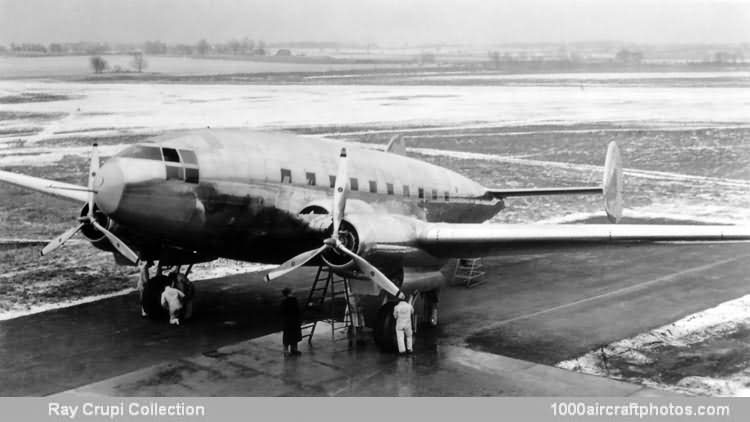08/31/2010. Remarks by Johan Visschedijk: "In 1937, George A. Page Jr., the chief aircraft designer at the St. Louis Division of Curtiss at St. Louis, Missouri, USA, undertook the design of an all-metal monoplane 36-passenger airliner as a follow-on to their earlier Condor biplane transport.
Introducing a new standard in pressurized airliners, the type had a patented 'figure-eight' or 'double-bubble' fuselage and featured twin vertical tail surfaces. The prototype, known as the CW-20T and powered by two 1,700 hp Wright R-2600 Cyclone fourteen-cylinder two-row air-cooled radial engines, first flew on March 26, 1940, with test pilot Eddie Allen at the controls. The twin small vertical tails were soon replaced by a large single vertical tail.
The internal volume of the fuselage was huge, a fact not lost on the USAAC, which placed an order for 25 militarized aircraft to be known as the C-46, immediately after the first flight. These were similar to the prototype but had Pratt & Whitney R-2800-43 eighteen-cylinder two-row air-cooled radial engines of 2,000 hp each in place of the original Wright power plants. The C-46 had fewer windows than the prototype, while the gross weight increased from 40,000 to 50,675 lb (18,144 to 22,988 kg).
While the first batch was under construction at the Buffalo, New York plant, the USAAF (as the USAAC had been renamed June 20, 1941) purchased the prototype under s/n 41-21041 in October 1941. Evaluated as the Model CW-20A C-55, it was eventually transferred under Lend-Lease to Great Britain and used by BOAC registered as G-AGDI, it was scrapped in 1943. In May 1942 the first C-46 was rolled out of the factory in Buffalo and was delivered to the USAAC in July. During 1942 the C-46 went into service with Air Transport Command and with Troop Carrier Command.
The C-46 was followed by the C-46A, which had a large cargo door in the rear fuselage and folding paratroop bench seats along the cabin walls. All told, the Buffalo plant built 1,039 C-46As, while at the Louisville, Kentucky plant a further 438 were assembled. The St. Louis Division produced a mere trickle (12 airplanes) while Higgins Industries of New Orleans, Louisiana, acting as an additional source of supply, received a contract for 500, which was terminated after the completion of just two aircraft. The C-46A was powered by two R-2800-51 engines and grossed 49,600 lb (22,226 kg).
C-46s almost singlehandedly kept China in the war after the fall of Burma in May 1942 and the consequent closing of the Burma Road from India into China. The only supply route open to that beleaguered nation was by air over the towering Himalayas, among the highest mountains in the world. Because of their greater load-carrying capability and performance at altitude compared with the Douglas C-47, the Curtiss C-46 Commando was pressed into use over 'the Hump' from India to China and back.
Dodging snowcapped mountains and prowling Zero fighters which hunted them amid the peaks, exposed to the most violent weather in the world, the Commandos kept the precious supply line open. On one occasion, a C-46, under attack by a Japanese fighter, nosed the big transport over and dived for cloud cover at 11,000 ft (3,353 m). By the time the Commando hurtled past 20,000 ft (6,096 m) it was diving at more than 405 mph (652 kmh). The laden transport managed to hold together under the terrific stress of the dive recovery after it had reached the clouds, and, from the comparative safety of the cloud cover, completed its mission.
In 1944, a single C-46A was converted into the sole XC-46B with R-2800-34W engines and a new stepped windshield instead of the conventional faired one. The windshield modification was not immediately adopted. Instead, the next model, the C-46D, retained the original engines and the -51 engine but had detail cargo door and nose modifications. The Buffalo plant built 1,410 C-46Ds and 234 of the similar C-46F with the R-2800-75 engine. St. Louis built seventeen C-46Es, which had the stepped XC-46B nose.
After the war C-46s were retained in operations, although many were sold as surplus or scrapped. The type remained in USAF inventory through the Korean War and were finally retired by Air Force Reserve Squadrons in 1960. As the R5C, the Commando was used by the Marine Corps for troop transport in the island-hopping campaign in the Pacific. One hundred sixty of the R5C-1, equivalent to the C-46A, were used by the Marine Corps. As with the USAAF models they served for several years beyond the end of World War II."
